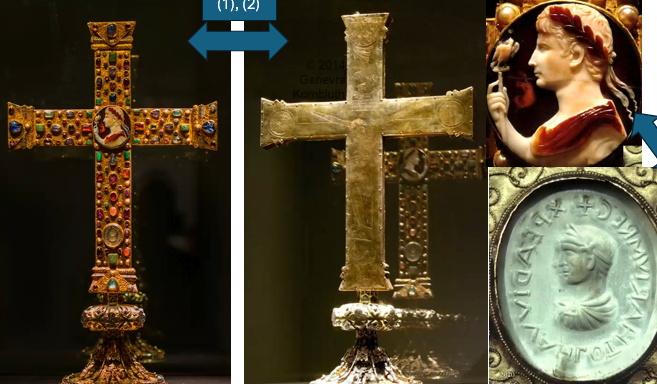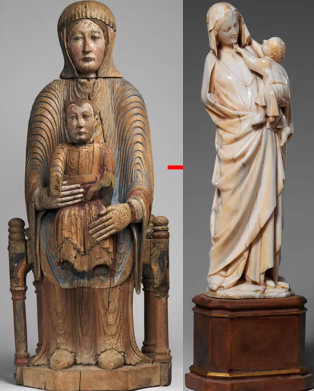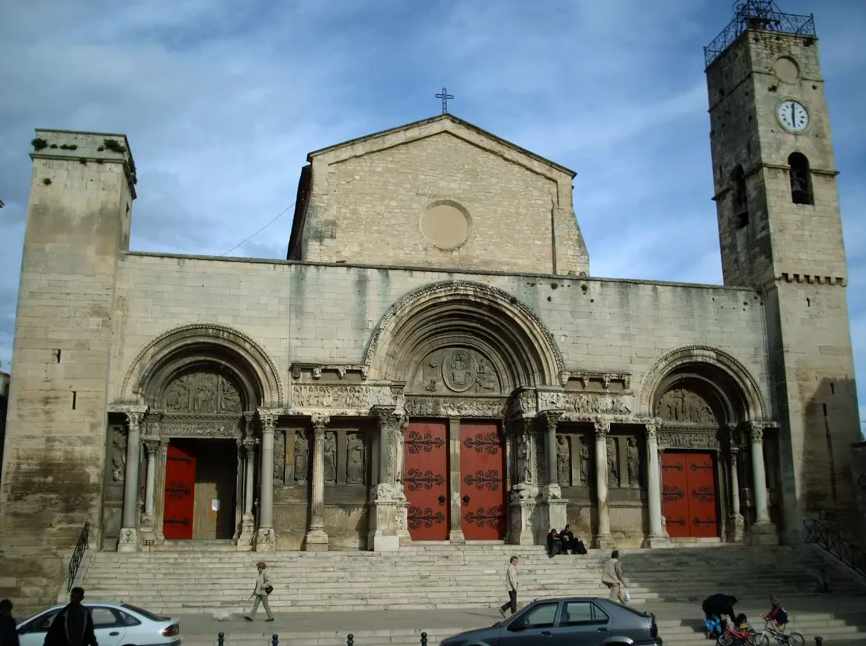Lecture 3: In Between What? The “Middle” Ages
1/10
There's no tags or description
Looks like no tags are added yet.
Name | Mastery | Learn | Test | Matching | Spaced |
|---|
No study sessions yet.
11 Terms
Tensions in the Middle Ages vis-à-vis classical art (2)
Christian beliefs:
(1) There should be no inappropriate veneration of images (in the Ten Commandments in the Old Testament)
Belief that images hold agency to corrupt: capable of inspiring BOTH devotion & sin
(2) God as the foremost creator/artist
Yet, people converting to Christianity were also polytheistic Romans beforehand; familiar w/ pagan devotional images
How did medieval (Christian) artists redeploy the pagan Classical past to their own ends? (2)
Artists borrowed directly from Roman iconography (= visual continuity w/ the classical past), BUT changed their meanings
Funerary contexts: underground, dimly-lit catacombs
E.g. Good shepherd (Christ) (3rd century), Domitilla catacomb, Rome & the Ram-bearer (‘Kriophoros’)
Architecture: razing & spoliation
Roman temples were razed to build early Christian churches
Churches copied floorplans of Roman civic secular spaces (e.g. basilicas)
Incorporation of actual pieces of Roman buildings into the fabric of the church (e.g. columns)
E.g. the church of Santa Sabina
= display of power
Renaissance vs. Renascences
Erwin Panofsky’s thesis (1960):
The Italian Renaissance is preceded by 2 earlier Renascences
(1) Carolingian renovatio (800-887)
Charlemagne was crowned Emperor in Rome by the pope in 800 CE
Wanted to reinstate the grandeur of the Roman Empire through unity of the church & state
Cultural revival to raise educational standards
E.g. every monastery had to have a school where classical & religious texts were copied
Idea that the Roman Empire is not only continued through him, but perfected through Christianity
Characteristics of Carolingian art:
(1) New emphasis on the human figure
(2) Styles of depicting humans were inspired in part by classical models
E.g. classicising drapery; personifications of natural forces
Gave the evangelists power & authority by linking them to the classical past (esp. classical philosophers)
(2) (early) Gothic Art (1200s)
Historical context
1st translations of original Greek (scientific & philosophical) texts = renewed interest in classical texts
Birth of the University
Ways of engaging w/ the classical past
Medieval artists shaped ideas about classical figures (e.g. Aristotle) to their own liking
Representation of the human body in more ‘naturalistic’ (classical) ways
YET also estrangement from the classical past (e.g. Gothic architecture > Romanesque)
BUT neither are fully successful in reintegrating classical form & content together
‘While medieval writers & artists felt a strong continuity & association w/ classical ideas, they lacked a historicism, perspective, & distance to see the visual forms of earlier culture with objective distance.’
'Classical art was immobilised by having been transplanted to the foreign soil of a Christian narrative’
Like Ernst Kitzinger: Medieval art has a stiffness & awkwardness, imitates traditional forms w/o truly capturing its spirit/beauty
Michael Camille’s response (1989):
Panofsky is NOT wrong about the disjunction between form & content in medieval appropriations of the antique
BUT Panofsky fails to recognise the savvy & strategic ways that medieval artists harness the styles, iconography, authors, & materials of classicism to their own ends
Transfer of power > tedius transmission of models
Medieval artists may not have intended to refer to meaning, but reinvent it
Spoliation vs. Appropriation
Spoliation
Forcibly taking, looting, or plundering of older materials [spolia] (sometimes stolen goods, e.g. war booty) in a newer object/space
Implies violence, illegality, or coercion
Appropriation
The adoption/use of elements of one culture by members of another culture, often without permission/understanding
It can happen without force, but is often criticized for power imbalances and lack of consent or credit

Lothair Cross (ca. 1000 CE)
w/ 1st century sardonyx cameo of Roman Emperor Augustus & seal matrix of Lothair
At the centre of the cross
Surrounded by a number of other gems, including a greenish rock crystal seal w/ an image of a Carolingian ruler, Lothar the 2nd
Died ~100 years before this was made
w/ inscription ‘Christ help King Lothar’
Other side: image of Christ on the cross
(1) The artist christianised Augustus by putting him on the cross
(2) Shows the ways that Christ & the earthly ruler coincide
They govern heaven & earth together
(3) Links Augustus w/ the Carolingians & the Ottonians (patrons of this cross)

Aquamanile in the form of Aristotle & Phyllis (late 14th/15th century)
Historical context
Aquamanile: a vessel that holds perfumed water to wash one’s hands
Probably would have been at the centre of a large banquet table, used at dinner parties etc.
Short story: first appeared in the 12th century
Aristotle was tutoring Alexander the Great
Aristotle advises Alexander to avoid Phyllis, the seductive mistress of his father (the King)
Phyllis is annoyed and plays a trick on Aristotle
Orchestrates a chance encounter w/ Aristotle & flirts w/ him
Gets him to want to sleep w/ her
BUT says she won’t do anything until he gets on his hands & knees and acts like a donkey
Alexander walks in at this moment & Aristotle is embarrassed
Description
A woman named Phyllis riding Aristotle as if he were a horse
Interpretation
Medieval artists shaped ideas about classical figures (e.g. Aristotle) to their own liking
Even the wisest men like Aristotle could be manipulated/ridiculed by women

Virgin & Child “Throne of Wisdom” (ca. 1150-1200 CE) vs.
Virgin & Child (13th century Paris), ivory
Posture
Throne of Wisdom: bodies are static, Virgin Mary as a physical throne on which Christ is sitting
Vs. ivory: contrapposto (= ‘the Gothic sway’)
Works w/ natural shape of elephant tusk
Naturalism
Ivory: more naturalistic depiction of the r/s between mother & child
More warm, friendly
Emphasises humanity of the Virgin Mary
Makes her more empathetic, human, & easier to connect with
Makes it a more effective devotional object
Michael Camille, ‘Idols of the Pagans’ (3 + 3)
Medieval people condemed idolatry & depicted a retreat from Roman idols [rejection, fear]
At the same time, medieval art often borrowed from classical forms [fascination, admiration for beauty, unavoidability]
How did Medieval Christians handle this paradox?
(1) Reintepretation of classical statues through aesthetic appreciation
Classical sculptures taken out of their original religious context, admired for their artistic beauty
‘The aesthetic anaesthetises’
= allowed Christians to engage w/ pagan art w/o feeling like they were committing idolatry
(2) Recontextualisation of pagan art through Allegory
Given new definitions/meanings within a Christian framework
E.g. classical gods were often reimagined as moral lessons: Venus represented vanity, Mars symbolised violence
= allowed Christians to appreciate pagan art w/o embracing its original (venerative) religious meanings
(3) Creation of new Christian idols/cult images (e.g. the cross, statues of saints)
By reinterpreting classical forms, medieval artists asserted the dominance of Christianity while secretly preserving the beauty & power of the pagan past
Michael Camille, ‘Idols of the Pagans’
The problem of nudity
Nudity was viewed differently in the Middle vs. Classical ages
Classial antiquity: symbolised beauty & hreoism; a site of visual veneration
Middle ages: associated w/ sin, shame, & the Fall of Man
The 2 sins of fornication (necessitating nudity) & idolatry are closely linked
NO distinction between the naked & the nude
How did medieval artists deal visually w/ naked bodies?
Banishing them to the margins/decorative confines
Displaying them as emblems of evil
Because the body is used as a negative example, the artist can be explicit & even ‘nautralistic’ in its depiction
Insertion into biblical allegory
Moralising tradition of using veiling/clothing as allegorical metaphors
E.g. Venus as naked, because she leaves her admirers ‘stripped bare’ of virtue

St. Gilles-du-Gard (façade), France
Historical context
Romanesque (‘Roman-like’) style
Influence of Roman architecture during the Middle Ages
Description
Rounded arches
Resembles the Arch of Constantine
Commemorated military victories
Linda Seidel (art historian): represents the transposition of the Roman triumphal arch
Originally marked a secular victory
In this case, marks the victory of the Christian church
Interpretation
NOT just reflecting an innocent love of Roman forms
But co-opting the logic of Roman architectural forms to Christianity’s ends
Linda Seidel (art historian): represents the transposition of the Roman triumphal arch
Originally marked a secular victory
In this case, marks the victory of the Christian church

Central Portal of Vézelay, France
Historical context
Central doorway of the Vézelay Abbey
Description
Scenes of the Last Judgement & other stories in the life of Christ
Interpretation
Roman architectural forms become a powerful space for Christian narratives
A new usage